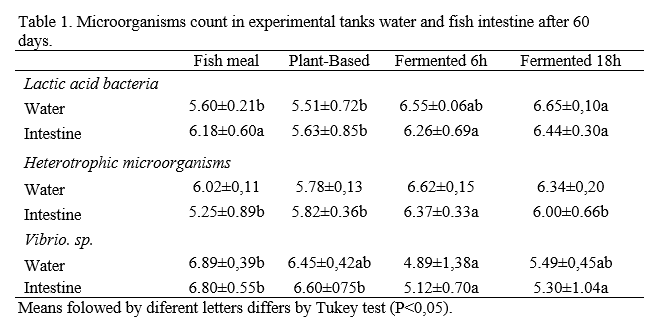FERMENTATION OF PLANT-BASED FEEDS WITH Lactobacillus acidophilus ACIDOPHILUS MODULATES MICROORGANISMS POPULATIONS IN WATER AND IN THE INTESTINE OF JUVENILE NILE TILAPIA Oreochromis niloticus REARED IN BIOFLOC SYSTEM
Introduction
The use of fermented feeds for tilapia reared in a biofloc system (BFT) could have positive impact fish physiology and water microbiota. We hypothesize that plant-based fermented feeds will modulate the BFT microorganisms through interactions between the components of the fermented product and the heterotrophic microorganisms present in the water. The objective of this study is to acess the effect of a plant-based fermented feed on the count of microorganisms in the water and intestine of juvenile Nile tilapia (Oreochromis niloticus ) reared in a biofloc technology (BFT) system.
Materials and methods
Plant-based feeds for Nile tilapia, fermented for 6 and 18 hours, were compared with a positive control diet containing fishmeal and a negative control diet without animal protein. The experimental design was completely randomized, with four treatments and six replicates. The diets were isoproteic (33% CP) and isoenergetic (4100 kcal kg⁻¹). The plant-based feed was fermented with Lactobacillus acidophilus following a methodology adapted from Azarm and Lee (2014). Juvenile Nile tilapia (8.3 ± 0.2 g) were distributed into 24 tanks (70 L), with 17 fish per tank. After 60 days, water samples were collected from each tank for microorganism enumeration. Intestinal samples were also collected from three fish per tank for microorganism count analysis. Differences between results were assessed using analysis of variance (ANOVA) and Tukey’s test (P<0.05).
Results
Feed fermented for 18h increased (P<0.05) the acid lactic bacteria count in the water compared to fish meal and plant-based diets (Table 1). A reduction (P<0.05) in Vibrio sp. was observed in the water of the tanks that received the feed fermented for 6h relative to the fish meal diet. At the end of the trial, the concentration of heterotrophic bacteria in the intestines of Nile tilapia fed feed fermented for 6h was higher (P<0,05) than in the rest of the dietary groups. Levels of intestinal acid lactic bacteria were lower (P<0.05) in the fish that received plant-based feeds. The Vibrio sp. count was lower (P<0.05) Vibrionaceae family in the fish treated with fermented plant-based feeds.
Discussion
The use of fermented feeds positively affected the count of microorganisms in water in the BFT tanks. The increase in LAB during fermentation may have contributed to the reduction in Vibrio sp. The use of probiotics has already been demonstrated to be effective in BFT systems to control pathogenic bacteria in water (He et al., 2023). Regarding the bacteria counts in intestine, an increase in the count of heterotrophic bacteria and acid lactic bacteria was observed in fish fed with fermented feeds. The increase in intestinal acid lactic bacteria agrees with the increase count in water samples, since there is generally a sound correlation between the intestinal microbiota in fish and those of the environment (Turner et al., 2022). A similar modulation effect could have been observed in the reduction in Vibrio sp . through the feed and biofloc particles.
Conclusions
The use of plant based based fermented feeds increased the abundance of beneficial bacteria counts and reduced the pathogenic bacteria in the water of the BFT system and in the fish intestine.
References
Azarm, H.M.; Lee, S.M. Effects of partial substitution of dietary fish meal by fermented soybean meal on growth performance, amino acid and biochemical parameters of juvenile black sea bream Acanthopagrus schlegeli . Aquac. Res. 2014, 45, 994–1003.
He, X.; Abakari, G.; Tan, H.; Wenchang, L.I.U.; Luo, G. Effects of different probiotics (Bacillus subtilis) addition strategies on a culture of Litopenaeus vannamei in biofloc technology (BFT) aquaculture system. Aquaculture 2023, 566, 739216.
Turner, K.; Solanki, N.; Salouha, H.O.; Avidor-Reiss, T. Atypical centriolar composition correlates with internal fertilization infish. Cells 2022, 11, 758.

